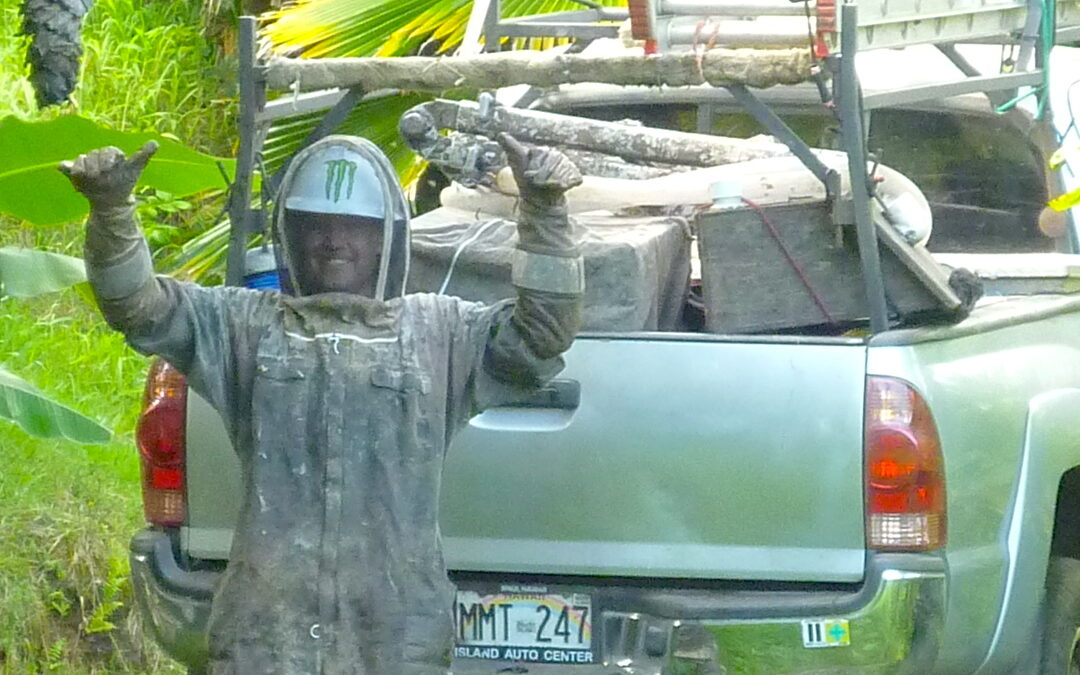
by Lorraine Brodek | Jun 19, 2014 | Blog
The hardest worker you have tending your garden is the one who starts at the crack of dawn and quits when the sun goes down, doesn’t need direction, is tireless in his pursuit of keeping your flowers blooming and your fruit fruiting, immigrates across borders and is happy to work for FREE–which rhymes with–BEE (meli in Hawaiian).
 In my book, A Nobody in a Somebody World, the third chapter is titled The Savage Bees. Husband Tom supervised production of this killer bee flick back in the 80’s when there was a wild frenzy going on about angry bees crossing our borders bringing venom and viciousness with voracity (the three bee “v’s”) as they targeted their prey.
In my book, A Nobody in a Somebody World, the third chapter is titled The Savage Bees. Husband Tom supervised production of this killer bee flick back in the 80’s when there was a wild frenzy going on about angry bees crossing our borders bringing venom and viciousness with voracity (the three bee “v’s”) as they targeted their prey.
Fortunately, we have always had contented, busy bees to keep our Maui garden humming..so to say. No worries about their having a ho’omainoino (mean) streak. That is..until the other day when the menfolk started running every which way and screaming like womenfolk. Their voices went into the high decibel frequency range..”Ee-eeee-ee!” Also rhymes with bee. There are a few things that normally happy bees don’t like. They don’t like noisy weed-eaters. They don’t like swinging machetes chopping and they definitely don’t like their hive poked with a stick. When all three of these things happen at the same time, it’s like living in Oakland and the drones pull out the big guns and go on the attack. That’s when we realized we had a hive in the ‘hood. We didn’t know that. The Queen decided that she’d set up light housekeeping and/or beekeeping by our #4 water tank. The prime real estate she selected was the box that also houses the pump..warm and cozy with a great view.
When all three of these things happen at the same time, it’s like living in Oakland and the drones pull out the big guns and go on the attack. That’s when we realized we had a hive in the ‘hood. We didn’t know that. The Queen decided that she’d set up light housekeeping and/or beekeeping by our #4 water tank. The prime real estate she selected was the box that also houses the pump..warm and cozy with a great view.
Bees are a valuable commodity here on Maui where flower farms abound, waterlilies float leisurely in the ponds, all manner of tropical fruit is abundant and the macadamia nut trees produce like crazy. Another great benefit of this is the Hawaiian practice of sharing and/or bartering. We just traded our limes and lemons with our neighbors (Eileen and Rene of Hana Herbs) for Rene’s fresh fish (Ahi) of the day. A win-win! So preservation of bees is first and foremost. Obviously our hive had to be moved to a more remote area so that the human menfolk could claim their space back and have fun with their tools again. It was time to call Ken.
Another great benefit of this is the Hawaiian practice of sharing and/or bartering. We just traded our limes and lemons with our neighbors (Eileen and Rene of Hana Herbs) for Rene’s fresh fish (Ahi) of the day. A win-win! So preservation of bees is first and foremost. Obviously our hive had to be moved to a more remote area so that the human menfolk could claim their space back and have fun with their tools again. It was time to call Ken.
Ken Darr loves bees! Nothing makes him happier than a healthy, thriving hive with glistening, oozing honeycombs inside. He also harvests delicious honey, which provided a sweet bee benefit for removing our swarm. He arrived in his pickup ready to collect his new group of productive little farm workers. Hundreds of ’em..all energized and pumped up at the pump box.  Of course a heavy zip-up bee suit is the first requirement for retrieving bees, including long thick gloves and a sturdy mesh hood for head protection. Ken kinda looked liked a dirty astronaut. Personally, I don’t think he has ever washed his bee suit..but bees don’t care about that stuff. However, it would be the supreme test to see if Tide Ultra Stain Release really works. Now that I think about it, you wouldn’t want a super good beekeeper to arrive in a squeaky clean bee suit.
Of course a heavy zip-up bee suit is the first requirement for retrieving bees, including long thick gloves and a sturdy mesh hood for head protection. Ken kinda looked liked a dirty astronaut. Personally, I don’t think he has ever washed his bee suit..but bees don’t care about that stuff. However, it would be the supreme test to see if Tide Ultra Stain Release really works. Now that I think about it, you wouldn’t want a super good beekeeper to arrive in a squeaky clean bee suit.
None of us realized the magnitude of Ken’s challenge. When he lifted the box lid, it was determined that the queen was really popular and her staff had created lots and lots of honeycombs–all yellow and thick. Like about 100 pound’s worth of bees, combs and goo. The easiest solution was for Ken to just take the entire box. Fortunately, he’s a strong guy–plus now he was as pumped up as the bees for finding such a liquid gold treasure trove for his honey business. He wrapped the box with a tarp to contain most of the residents and calm them down. Then he lifted the box and loaded it into the back of his pickup. Last we saw of Ken, he was headed down the jungle road, with straggler wanna bees following close behind as they all headed off to a quieter neighborhood. I was thinking what a great thing it is to have a live bee hive in your truck. That way you don’t have to have a car alarm or a wheel lock. Or you don’t have to worry about someone parking too close to you and dinging your doors at Walmart. Or you don’t have to worry about the cops pulling you over for an expired safety sticker on your bumper. That’s a must-have here in Hawaii.
Last we saw of Ken, he was headed down the jungle road, with straggler wanna bees following close behind as they all headed off to a quieter neighborhood. I was thinking what a great thing it is to have a live bee hive in your truck. That way you don’t have to have a car alarm or a wheel lock. Or you don’t have to worry about someone parking too close to you and dinging your doors at Walmart. Or you don’t have to worry about the cops pulling you over for an expired safety sticker on your bumper. That’s a must-have here in Hawaii.
My first decision of the day is whether to have Ken’s macadamia nut wild honey or his Happy Valley honey on my toasted bagel. Obviously “our” bees are happy and contented in their new digs and Ken’s Alii (appropriately that’s Hawaiian-speak for Queen) Beekeeping business should be a buzz of activity.
Obviously “our” bees are happy and contented in their new digs and Ken’s Alii (appropriately that’s Hawaiian-speak for Queen) Beekeeping business should be a buzz of activity.
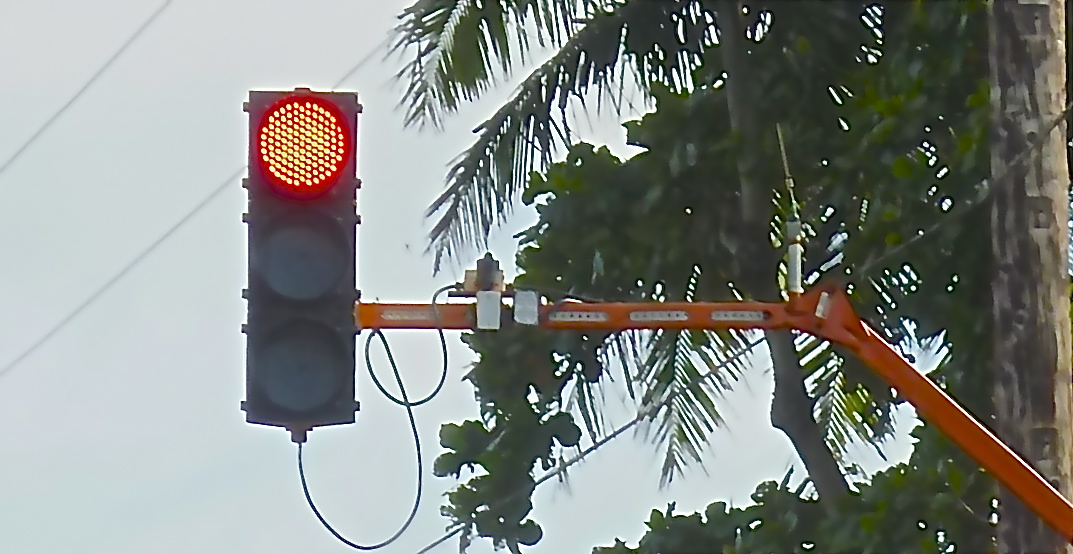
by Lorraine Brodek | Jun 7, 2014 | Blog
If you are dreaming of paradise..I bet “no traffic” might be in that dream. No freeways, no congestion, no wasting valuable hours of life on asphalt.
 Hana is that paradise place. We have always been free to come and go until the stop lights! But they are temporary. The definition of temporary in Hawaii is “not permanent; established with the idea of being changed soon.” The definition of soon in Hana can be “the short span of time existing somewhere between two hours, two days, two months or two years.” The slow pace of paradise applies to “any kine (i.e. kind) project–small kine, big kine.”
Hana is that paradise place. We have always been free to come and go until the stop lights! But they are temporary. The definition of temporary in Hawaii is “not permanent; established with the idea of being changed soon.” The definition of soon in Hana can be “the short span of time existing somewhere between two hours, two days, two months or two years.” The slow pace of paradise applies to “any kine (i.e. kind) project–small kine, big kine.”
And most projects involve backstories. Such is the case for the cause of the stoplights. In the late 1800’s, Hana used to be a thriving hub of the sugar cane industry. A train ran between our verdant hills and pasture lands delivering sugar cane to the mill on the “other side” of the island near Kahului (Ka-hoo-loo-ee). The Chinese provided a substantial portion of the work force. Consequently, the cane-train engineer was “pākē” (Hawaiian for Chinese). And legend has it that sākē (Japanese rice wine) kept him hydrated on his return trip to Hana after his long clickety-clack train track trip through the jungle. Getting closer to home, he rounded a 90-degree bend (probably going a wee bit wikiwiki (weekee-weekee as in fast) due to DUSI (driving under sākē impairment). As with most “Dead Man Curves,” the name lives in perpetuity and does not die as is usually the case with the driver–now deceased. So for over 150 years years, this Hana bridge has been called “Mākē Man Bridge.” In Hawaiian, “Mākē” means dead.
lands delivering sugar cane to the mill on the “other side” of the island near Kahului (Ka-hoo-loo-ee). The Chinese provided a substantial portion of the work force. Consequently, the cane-train engineer was “pākē” (Hawaiian for Chinese). And legend has it that sākē (Japanese rice wine) kept him hydrated on his return trip to Hana after his long clickety-clack train track trip through the jungle. Getting closer to home, he rounded a 90-degree bend (probably going a wee bit wikiwiki (weekee-weekee as in fast) due to DUSI (driving under sākē impairment). As with most “Dead Man Curves,” the name lives in perpetuity and does not die as is usually the case with the driver–now deceased. So for over 150 years years, this Hana bridge has been called “Mākē Man Bridge.” In Hawaiian, “Mākē” means dead.
Back in the “old days,” our highways used to feature Burma Shave sequential signs. Burma Shave was one of the first brushless shaving creams and the company came up with a fun advertising gimmick.  There’d be about five to six smallish wooden signs pounded into the ground or hammered onto poles or posts along the side of the highway. Mākē Man Bridge would have been a perfect place for such signs. With slight improvisations, the ditties could have gone something like this: “Train in ditch, Engineer in tree. Moon was full, And so was he. Burma Shave.” or..”The train is in pieces, Get the shovel and rake. He grabbed for the Sākē, Instead of the brake. Burma Shave.”
There’d be about five to six smallish wooden signs pounded into the ground or hammered onto poles or posts along the side of the highway. Mākē Man Bridge would have been a perfect place for such signs. With slight improvisations, the ditties could have gone something like this: “Train in ditch, Engineer in tree. Moon was full, And so was he. Burma Shave.” or..”The train is in pieces, Get the shovel and rake. He grabbed for the Sākē, Instead of the brake. Burma Shave.”
Through the years, there have been a few more “incidents” on Mākē Man Bridge including tumbling boulders in water rapids flowing underneath . Some of these banged into the support pilings holding up this span over the curve and it was determined that its strength was structurally weakened–as in–it could fall down with the next cement truck and/or fully loaded tour bus crossing over it. So what to do..
. Some of these banged into the support pilings holding up this span over the curve and it was determined that its strength was structurally weakened–as in–it could fall down with the next cement truck and/or fully loaded tour bus crossing over it. So what to do..
The bridge repairs needed to start–but first it needed to be torn down, meaning cutting off that portion of the Hana Highway. The county determined that they could create a detour down the quaint scenic road that meanders by beautiful Koki (Ko-key) Beach, magnificent Alau (allow) Island and Hamoa Beach which is #5 on Dr. Beach’s Top-10 Best Beach List for 2014 (www.drbeach.org). Trouble is this charming road is essentially a single lane in most parts, but it’s never been a problem for any of us. We just pull to the side being careful not to leave a fender in a lava rock wall when opposing traffic comes our way. And we just back up for school buses and monsta trucks.
The county determined that with the increased traffic caused by the highway closure, that this little road needed traffic signals (!) to prevent congestion and protect our safety in paradise. So about a half-mile stretch of asphalt is controlled by “never-before-in-Hana” traffic lights.  My own independent survey has determined that one never reaches the signals when they are green–meaning that you sit for seven minutes as you wait for opposing vehicles or vehicle to come through. This effort requires your inner Zen. Breathe in. Breathe out. Sit. Bring your ukulele. Strum and hum. The man in the beat-up pick-up in front of me with the bumper sticker that said, “Patience–Jesus is coming back”–well, he must have borrowed that truck from the pastor because he sat for maybe 30 seconds and then ran the red. The “Barney Fife” cop was waiting just up the road behind the hibiscus and nabbed him. $97 fine. The other benefit of waiting is the scenery surrounding you that provides pure enjoyment. Most don’t realize what’s on the other side of those Kamani trees that you are stopped under. Look a little to the left and behind you and you can watch the ocean waves touch the shore as they splash in from Alau Island. Roll down your windows. Breathe the salt air and fragrance of the plumeria blossoms. Now that’s paradise.
My own independent survey has determined that one never reaches the signals when they are green–meaning that you sit for seven minutes as you wait for opposing vehicles or vehicle to come through. This effort requires your inner Zen. Breathe in. Breathe out. Sit. Bring your ukulele. Strum and hum. The man in the beat-up pick-up in front of me with the bumper sticker that said, “Patience–Jesus is coming back”–well, he must have borrowed that truck from the pastor because he sat for maybe 30 seconds and then ran the red. The “Barney Fife” cop was waiting just up the road behind the hibiscus and nabbed him. $97 fine. The other benefit of waiting is the scenery surrounding you that provides pure enjoyment. Most don’t realize what’s on the other side of those Kamani trees that you are stopped under. Look a little to the left and behind you and you can watch the ocean waves touch the shore as they splash in from Alau Island. Roll down your windows. Breathe the salt air and fragrance of the plumeria blossoms. Now that’s paradise.

Saving good news for last: the mayor is coming to Hana on June 17th to officially open Mākē Man Bridge. Thanks to the great county road crew they redefined temporary into soonest. And the red-light district will soon be just a glowing memory.
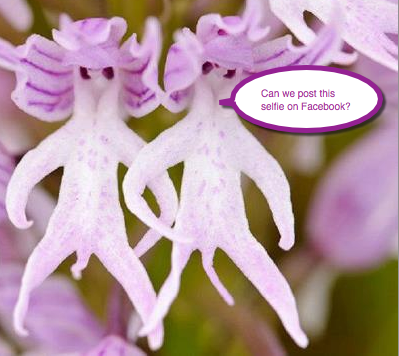
by Lorraine Brodek | May 28, 2014 | Blog
There is no singular word in Hawaiian for the physical universe, so obviously nature takes on many forms, shapes and sizes in Hawaii–not to mention humor. My friend, Jil, asked me not to show any more poop pictures and instead asked to see some flowers in our Maui garden.  Since I’m thrilled to have one friend who actually reads my stuff, I’m more than happy to oblige. So I opened up some of my iPhoto albums and, of course, the first flowers that caught my eye were orchids. Did you know that there are about 35,000 species of orchids in the world?! How many people did it take to count those things? I know for sure that we have a bunch of ’em at our house including some Cattleya and Phalaenopsis shown at right.
Since I’m thrilled to have one friend who actually reads my stuff, I’m more than happy to oblige. So I opened up some of my iPhoto albums and, of course, the first flowers that caught my eye were orchids. Did you know that there are about 35,000 species of orchids in the world?! How many people did it take to count those things? I know for sure that we have a bunch of ’em at our house including some Cattleya and Phalaenopsis shown at right.
Orchids do not grow in soil. They grow in the air by attaching their roots to hard surfaces that get washed by the rain. We have orchids growing on our lava walls, hanging out of our trees and everyone needs an orchid by their outhouse.  But here I am talking about poop again. I immediately emailed an orchid pic to Jil and lo and behold, it got her husband, George, all excited. He had just seen two amazing orchids on the internet and said I had to have them. He forwarded the photos my way and I couldn’t believe what I was seeing. I think they originate from Equador or Peru or somewhere down in those naked jungles, but I certainly believe they would be most happy growing on Maui. Of course, to get them here, we’d have to deal with the USDA, the IPPC, NAPPO, PHQG, the APHIS and PPQ programs, not to mention the EPA and the TSA. So perhaps a few pictures would do just as well.
But here I am talking about poop again. I immediately emailed an orchid pic to Jil and lo and behold, it got her husband, George, all excited. He had just seen two amazing orchids on the internet and said I had to have them. He forwarded the photos my way and I couldn’t believe what I was seeing. I think they originate from Equador or Peru or somewhere down in those naked jungles, but I certainly believe they would be most happy growing on Maui. Of course, to get them here, we’d have to deal with the USDA, the IPPC, NAPPO, PHQG, the APHIS and PPQ programs, not to mention the EPA and the TSA. So perhaps a few pictures would do just as well.
Photos #1 and #2 in this series show “The Hanging Naked Man Orchid.” I think a much better name would be “The Anthony Gigantea Weiner Orchid:”

#3 in the series is called the Monkey Orchid or Orchis Simia. My suggestion for a more fun name would be: “The Donald Trumpus Follicus Orchid.” 
No blow-dry necessary and it’s naturally orange/blond. Arena flowers.com says it smells like ripe orange when it matures. That would match the hair. How great is that?
So now this whole flower and humor in the garden thing has got me going and I have just dug up a few more pictures from the file. Another phallic-type flower that we have in multiple sizes and colors under the palms and ferns is the Anthurium. It is also called the “Boy Flower.” No explanation necessary:


Hawaiians have this joke going around that I thought I should warn you about so you are prepared for the question. Here it is: How do you tell the difference between a male and female Plumeria tree? This question can also apply to any tree like a Mango or Guava for example. Here is the answer: the picture on your left is the female and the one on the right is the male:

Some Hawaiian fisherman hang their buoy balls in trees. What are buoy balls? Well..they’re really fish net floats that keep the huge expanse of fishing nets afloat in the ocean. They used to be handmade of glass by glassblowers using old Sake bottles, but are now made of plastic or aluminum. Appropriately, there are two balls in the male tree above.
Since I seem to be focusing on the male of the species in plant life as we know it..I do have one photo that shows a female lime having a mammogram.  She had grown naturally between these two branches. Poor thing I rescued her just in time. And she thanked me by blessing my Mai Tai that night:
She had grown naturally between these two branches. Poor thing I rescued her just in time. And she thanked me by blessing my Mai Tai that night:
I shall now end this horticulture lesson with my thought for the day: Flowers bring beauty and fragrance to the outhouse of life:

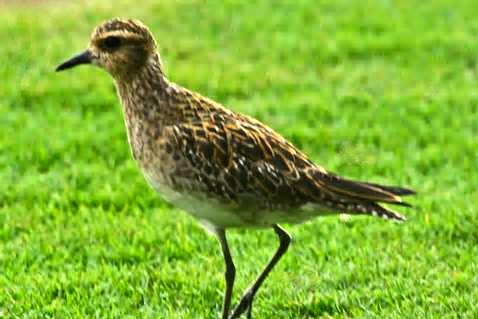
by Lorraine Brodek | May 21, 2014 | Blog
We named her Katie (Keke in Hawaiian). Kolea is Hawaiian for golden plover. It’s botanical name is Pluvialis fulva which sounds like an organ  from which a gynecologist might take a pap smear. Or..in the case of the male..it could be the title of the next spy flick: Agent 007–The Man with the Golden Plover. Appropriately..a plover is a bird.
from which a gynecologist might take a pap smear. Or..in the case of the male..it could be the title of the next spy flick: Agent 007–The Man with the Golden Plover. Appropriately..a plover is a bird.
And a rather amazing bird at that. “Our” tougher plover just left us for its winter home. If you want a lesson in perseverance, endurance, risk-taking and all-around spunk–this is the bird to teach you that. Katie arrived on our lawn last year in August. We weren’t able to pinpoint the exact date because we were “off-island” then, but we do know that our plover departed three weeks ago on April 26th.
And “Where for art thou flying?” you might ask this feathery little shorebird. Well..all the way back to the western shores of Alaska from the Hawaiian  Islands–50 non-stop hours going about 50 mph at 20,000 feet with wings flapping (about two wing-beats per second) over 2,500 miles of open ocean! No coasting, no soaring, no gliding. And if you think that’s bad, koleas can’t swim! Ornithologist, Dr. Oscar “Wally” Johnson, put it this way, “Imagine that flight you made from L.A. to Honolulu–only without a plane.” And we complain because we’re in the back of coach and airlines seem to be slowing flights these days to save fuel.
Islands–50 non-stop hours going about 50 mph at 20,000 feet with wings flapping (about two wing-beats per second) over 2,500 miles of open ocean! No coasting, no soaring, no gliding. And if you think that’s bad, koleas can’t swim! Ornithologist, Dr. Oscar “Wally” Johnson, put it this way, “Imagine that flight you made from L.A. to Honolulu–only without a plane.” And we complain because we’re in the back of coach and airlines seem to be slowing flights these days to save fuel.
These brown speckled birds start refueling and fattening themselves up the minute they touch down in Hawaii on our verdant lawns or golf courses–sometimes interrupting play on the back nine. Their on-land stride is a kind of “run-run-run–lift up a leg–stop–run-run” across the lawn with their beaks at the ready to snatch any beetle, cockroach, worm, centipede or creepy crawly–anything munchable underground.
Katie chose our rolling lawn as her territory. She staked it out and defended it at all costs..scaring away any other kolea who might think of  moving in for a snack as she flew after him with a shrill whistle and flapping wings. That way she protected her food source to be sure she had enough to last before her return trip. This is called “site faithfulness” and that’s why Katie reclaims our lawn every year now. It’s just unbelievable that she knows how to get here. She must have her own little GPS. Someone should put a Google Glass on her so we can see what her trip is like flying back to Alaska.
moving in for a snack as she flew after him with a shrill whistle and flapping wings. That way she protected her food source to be sure she had enough to last before her return trip. This is called “site faithfulness” and that’s why Katie reclaims our lawn every year now. It’s just unbelievable that she knows how to get here. She must have her own little GPS. Someone should put a Google Glass on her so we can see what her trip is like flying back to Alaska.
Kolea in Hawaiian means “one who takes and leaves.” Similar to when the kids head off to college..or when distant relatives come for a visit to your home on Maui. According to a Hawaiian proverb: “Ai no ke kolea a momona hoi I Kahiki!” or..the kolea eats until he is fat and then returns to the land from which he came. And the main reason for doing this is breeding. Of course–it’s always about sex. But here’s what a few parents I’ve known wish they could have done. Once kolea chicks are born, parents leave them mainly on their own to fend for themselves. When the adults leave for Hawaii (after chirping “Aloha, goodbye and good luck”), the kidlets are left to follow a few weeks later in a teen-age group all by themselves and somehow find their way to Hawaii.
Another interesting fact of nature is that the kolea usually precedes the humpback whale’s arrival and departure to and from the islands by a month. If I were a kolea, I’d just wait and hitch a ride back. A few weeks prior to leaving Hawaii, the male kolea grows what looks like little Nike swoosh logos on his head and neck with a black sleeveless shirt. Some think it looks like a little tuxedo as if he’s getting ready for the big orgy party. But when Katie started growing what looked like a little bow-tie, we realized that–“Oh no!”–it wasn’t Katie after all. She had been a he all along. Our grandson, Logan, always wanted to be named Karl. For some reason, he loves the name, so we transgendered Katie to Kala (Karl) Kolea.
prior to leaving Hawaii, the male kolea grows what looks like little Nike swoosh logos on his head and neck with a black sleeveless shirt. Some think it looks like a little tuxedo as if he’s getting ready for the big orgy party. But when Katie started growing what looked like a little bow-tie, we realized that–“Oh no!”–it wasn’t Katie after all. She had been a he all along. Our grandson, Logan, always wanted to be named Karl. For some reason, he loves the name, so we transgendered Katie to Kala (Karl) Kolea.
Then, come to find out, that our dear friend, Jeannie, told us that she has it on good authority that a herd or flock of koleas were seen gathering at Kahului, Maui airport (OGG). Now think about this..what if those birds had frequent flier miles with Alaska Airlines and they were allowed to jump on the moving cargo ramp and tag along in baggage all the way back to their winter home. That would like flying first class instead of flapping your wings for 2,500 miles way back in the coach section.
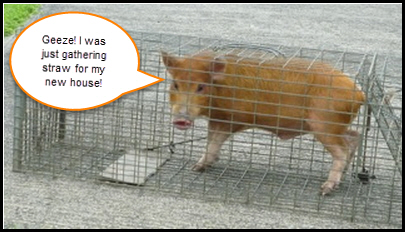
by Lorraine Brodek | May 13, 2014 | Blog
Baby pigs are nurtured in Hana because they grow up to be pua’a in the imu (big pig roasted in the under ground oven wrapped in banana leaves)–a big pig reason for a luau. But the Maui gardener wants them to stay in the jungle.
 One of the first hints that you might have a wild (feral) pig problem is poop. This seems to be the subject of a number of my ruminations recently. Ruminate is an appropriate word here because that’s what pigs do when they start chomping on the grubs, macadamia nuts, papaya and potatoes they find by rooting under vines and trees. Paradise isn’t always pretty because there’s a lot of free range everything. And no one makes it their mission to follow every pooping thing around with little plastic bags in hand and then deposit these collections in the green can. There are no green cans here. The natural jungle is our green can.
One of the first hints that you might have a wild (feral) pig problem is poop. This seems to be the subject of a number of my ruminations recently. Ruminate is an appropriate word here because that’s what pigs do when they start chomping on the grubs, macadamia nuts, papaya and potatoes they find by rooting under vines and trees. Paradise isn’t always pretty because there’s a lot of free range everything. And no one makes it their mission to follow every pooping thing around with little plastic bags in hand and then deposit these collections in the green can. There are no green cans here. The natural jungle is our green can.
So it was like a pig rerun or piggy-back (so to say) for me yesterday. The last chapter in my book, A Nobody in a Somebody World, is titled “Sows and Tsunamis in Hulawood.” One of my favorite things to do is to hop on my John Deere riding mower and cut grass. Better than therapy. I wrote how I was zipping around the bend near the neighboring jungle brush and guava trees when all of a sudden from behind the Tahitian lime tree I was confronted by a huge reddish brown wild sow with an amazing likeness to Don Rickles.
 She firmly planted her hooves into the ground in front of me, started with major snorting and oinking, and began her charge. No one, but no one, was going to put a scratch or a dent in my John Deere. So I revved it up into high gear, went eyeball-to-eyeball with my gnarly attacker, thrust my green machine into forward, and threw a lemon at her that I had saved in my cup holder. She backed off, but at that very second eight piglets came scurrying out from under the ferns and Pikake vines, all squealing and running amuck every which way.
She firmly planted her hooves into the ground in front of me, started with major snorting and oinking, and began her charge. No one, but no one, was going to put a scratch or a dent in my John Deere. So I revved it up into high gear, went eyeball-to-eyeball with my gnarly attacker, thrust my green machine into forward, and threw a lemon at her that I had saved in my cup holder. She backed off, but at that very second eight piglets came scurrying out from under the ferns and Pikake vines, all squealing and running amuck every which way.
I started screaming in my most threatening of voices, “Waho! Waho! (Out! Out!)” I figured it was best to give a shout-out in Hawaiian since they were local pigs. Tom heard this commotion and came zooming over in the Polaris Ranger. Within seconds, the boar appeared, all black, huge with tusks bigger than a mastodon’s. Tom grabbed his air horn, which is his favorite farming intercom device, and blasted away. It was now pig pandemonium, or in Hawaiian Pidgin-speak, everyting buckaloose (out of control). A few more blasts from the air horn and the porkers retreated. The pigs were trying to reclaim their territory in what is now our space and my garden.
 The tell-tail sign that it was “piggy-back” Monday was the black poop (and/or scat) all over “my” freshly mowed lawn. This discovery was at day’s end, so we didn’t implement Plan-A by calling our local pig hunters. We saved that assignment for the next day. We went to bed dreaming of spareribs. And then..awakened abruptly this morning by the shrill, loud, piercing squeal of a piglet. Obviously, instead of a ripe papaya on the ground, this little one was enticed by a yogurt container of Kashi Go Lean (crunchy cereal) that Tom had placed in the Have-A-Heart trap. He had set it the night before to catch a mongoose (looks like it’s distant ferret cousin) that had taken up residence in our lava wall.
The tell-tail sign that it was “piggy-back” Monday was the black poop (and/or scat) all over “my” freshly mowed lawn. This discovery was at day’s end, so we didn’t implement Plan-A by calling our local pig hunters. We saved that assignment for the next day. We went to bed dreaming of spareribs. And then..awakened abruptly this morning by the shrill, loud, piercing squeal of a piglet. Obviously, instead of a ripe papaya on the ground, this little one was enticed by a yogurt container of Kashi Go Lean (crunchy cereal) that Tom had placed in the Have-A-Heart trap. He had set it the night before to catch a mongoose (looks like it’s distant ferret cousin) that had taken up residence in our lava wall.
 We are usually a catch and release family. Our daughters would never forgive us if we conked this piglet on the head and used her for bacon. Miss Piggy, Babe, Porky and Sarah Palin have cured my urge to hunt and gather. Not to mention that cute Geico piggy. This now captured and caged little swine relative had definitely put on a few pounds–about 40 of ’em. Tom grunted as he lifted Babe into the back of the Ranger. I could hear her squealing as she and he drove off through the jungle together and down to the oceanfront pasture land where she can roam free and poop as much as she wants along with the cows and bulls and mongoose and chickens and pheasants. No wonder everything is so green down there in that pasture. Who needs a green can.
We are usually a catch and release family. Our daughters would never forgive us if we conked this piglet on the head and used her for bacon. Miss Piggy, Babe, Porky and Sarah Palin have cured my urge to hunt and gather. Not to mention that cute Geico piggy. This now captured and caged little swine relative had definitely put on a few pounds–about 40 of ’em. Tom grunted as he lifted Babe into the back of the Ranger. I could hear her squealing as she and he drove off through the jungle together and down to the oceanfront pasture land where she can roam free and poop as much as she wants along with the cows and bulls and mongoose and chickens and pheasants. No wonder everything is so green down there in that pasture. Who needs a green can.
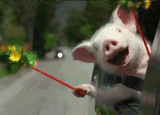
Hope your day is as happy as ours in Porkers’ Paradise!

 In my book, A Nobody in a Somebody World, the third chapter is titled The Savage Bees. Husband Tom supervised production of this killer bee flick back in the 80’s when there was a wild frenzy going on about angry bees crossing our borders bringing venom and viciousness with voracity (the three bee “v’s”) as they targeted their prey.
In my book, A Nobody in a Somebody World, the third chapter is titled The Savage Bees. Husband Tom supervised production of this killer bee flick back in the 80’s when there was a wild frenzy going on about angry bees crossing our borders bringing venom and viciousness with voracity (the three bee “v’s”) as they targeted their prey. When all three of these things happen at the same time, it’s like living in Oakland and the drones pull out the big guns and go on the attack. That’s when we realized we had a hive in the ‘hood. We didn’t know that. The Queen decided that she’d set up light housekeeping and/or beekeeping by our #4 water tank. The prime real estate she selected was the box that also houses the pump..warm and cozy with a great view.
When all three of these things happen at the same time, it’s like living in Oakland and the drones pull out the big guns and go on the attack. That’s when we realized we had a hive in the ‘hood. We didn’t know that. The Queen decided that she’d set up light housekeeping and/or beekeeping by our #4 water tank. The prime real estate she selected was the box that also houses the pump..warm and cozy with a great view. Another great benefit of this is the Hawaiian practice of sharing and/or bartering. We just traded our limes and lemons with our neighbors (Eileen and Rene of Hana Herbs) for Rene’s fresh fish (Ahi) of the day. A win-win! So preservation of bees is first and foremost. Obviously our hive had to be moved to a more remote area so that the human menfolk could claim their space back and have fun with their tools again. It was time to call Ken.
Another great benefit of this is the Hawaiian practice of sharing and/or bartering. We just traded our limes and lemons with our neighbors (Eileen and Rene of Hana Herbs) for Rene’s fresh fish (Ahi) of the day. A win-win! So preservation of bees is first and foremost. Obviously our hive had to be moved to a more remote area so that the human menfolk could claim their space back and have fun with their tools again. It was time to call Ken. Of course a heavy zip-up bee suit is the first requirement for retrieving bees, including long thick gloves and a sturdy mesh hood for head protection. Ken kinda looked liked a dirty astronaut. Personally, I don’t think he has ever washed his bee suit..but bees don’t care about that stuff. However, it would be the supreme test to see if Tide Ultra Stain Release really works. Now that I think about it, you wouldn’t want a super good beekeeper to arrive in a squeaky clean bee suit.
Of course a heavy zip-up bee suit is the first requirement for retrieving bees, including long thick gloves and a sturdy mesh hood for head protection. Ken kinda looked liked a dirty astronaut. Personally, I don’t think he has ever washed his bee suit..but bees don’t care about that stuff. However, it would be the supreme test to see if Tide Ultra Stain Release really works. Now that I think about it, you wouldn’t want a super good beekeeper to arrive in a squeaky clean bee suit. Last we saw of Ken, he was headed down the jungle road, with straggler wanna bees following close behind as they all headed off to a quieter neighborhood. I was thinking what a great thing it is to have a live bee hive in your truck. That way you don’t have to have a car alarm or a wheel lock. Or you don’t have to worry about someone parking too close to you and dinging your doors at Walmart. Or you don’t have to worry about the cops pulling you over for an expired safety sticker on your bumper. That’s a must-have here in Hawaii.
Last we saw of Ken, he was headed down the jungle road, with straggler wanna bees following close behind as they all headed off to a quieter neighborhood. I was thinking what a great thing it is to have a live bee hive in your truck. That way you don’t have to have a car alarm or a wheel lock. Or you don’t have to worry about someone parking too close to you and dinging your doors at Walmart. Or you don’t have to worry about the cops pulling you over for an expired safety sticker on your bumper. That’s a must-have here in Hawaii. Obviously “our” bees are happy and contented in their new digs and Ken’s Alii (appropriately that’s Hawaiian-speak for Queen) Beekeeping business should be a buzz of activity.
Obviously “our” bees are happy and contented in their new digs and Ken’s Alii (appropriately that’s Hawaiian-speak for Queen) Beekeeping business should be a buzz of activity.































 Lorraine is a former needlecraft designer who formed her own company (Fingerworks, Inc.)
during the 1970’s and 80’s. With this marketing experience, she ventured back into her chosen
field of film and television and rose up the ranks as an executive with Warner Bros. (Time-Warner). She is also a landscaping professional, author, humorist and artist. She has published four books: “The Tale of Peeky Peeper” (a fun children’s rhyming Holiday book, which she also illustrated); followed by her humorous memoir, “A Nobody in a Somebody World: My Hollywood Life in Beverly Hills.” Playfulness is the theme in whatever she does, as you’ll see in the two versions of her puzzle-like charted coloring books: “Griddles.” When she’s not creating something, you’ll find this 82 year-old grandma whacking a Pickle Ball, teaching movie
history, testing new recipes on her husband, Tom, or serving on the board of the Del Webb Performing Arts Center in Wickenburg, AZ.
Lorraine is a former needlecraft designer who formed her own company (Fingerworks, Inc.)
during the 1970’s and 80’s. With this marketing experience, she ventured back into her chosen
field of film and television and rose up the ranks as an executive with Warner Bros. (Time-Warner). She is also a landscaping professional, author, humorist and artist. She has published four books: “The Tale of Peeky Peeper” (a fun children’s rhyming Holiday book, which she also illustrated); followed by her humorous memoir, “A Nobody in a Somebody World: My Hollywood Life in Beverly Hills.” Playfulness is the theme in whatever she does, as you’ll see in the two versions of her puzzle-like charted coloring books: “Griddles.” When she’s not creating something, you’ll find this 82 year-old grandma whacking a Pickle Ball, teaching movie
history, testing new recipes on her husband, Tom, or serving on the board of the Del Webb Performing Arts Center in Wickenburg, AZ.